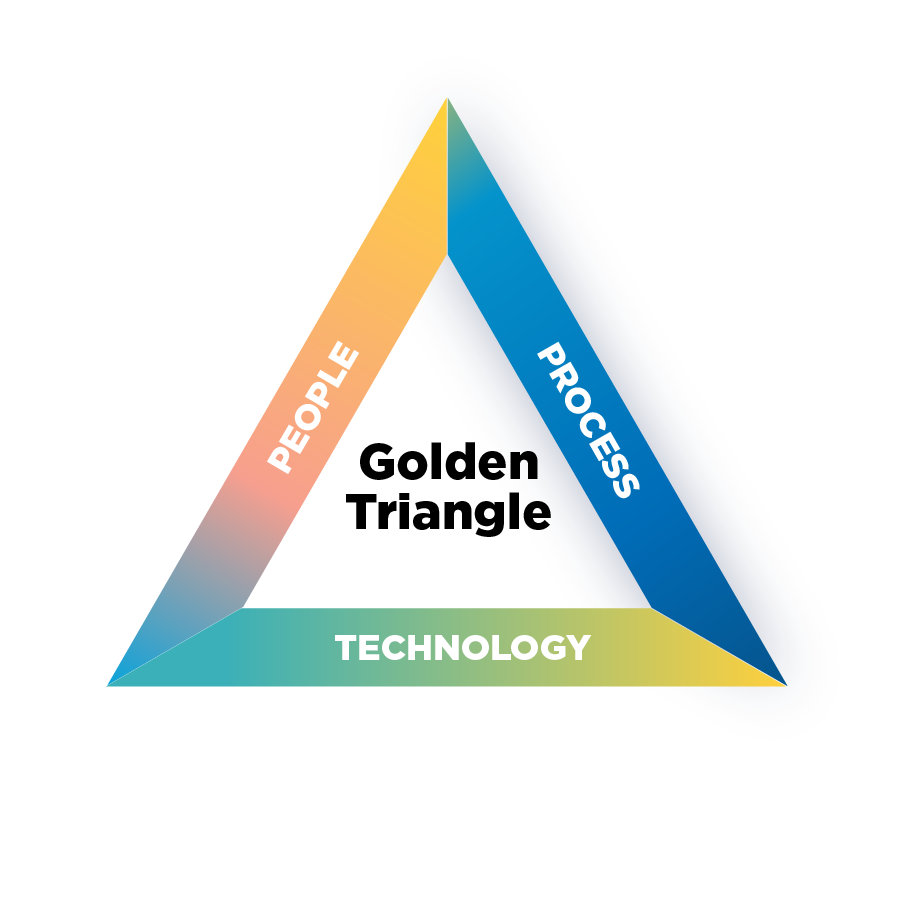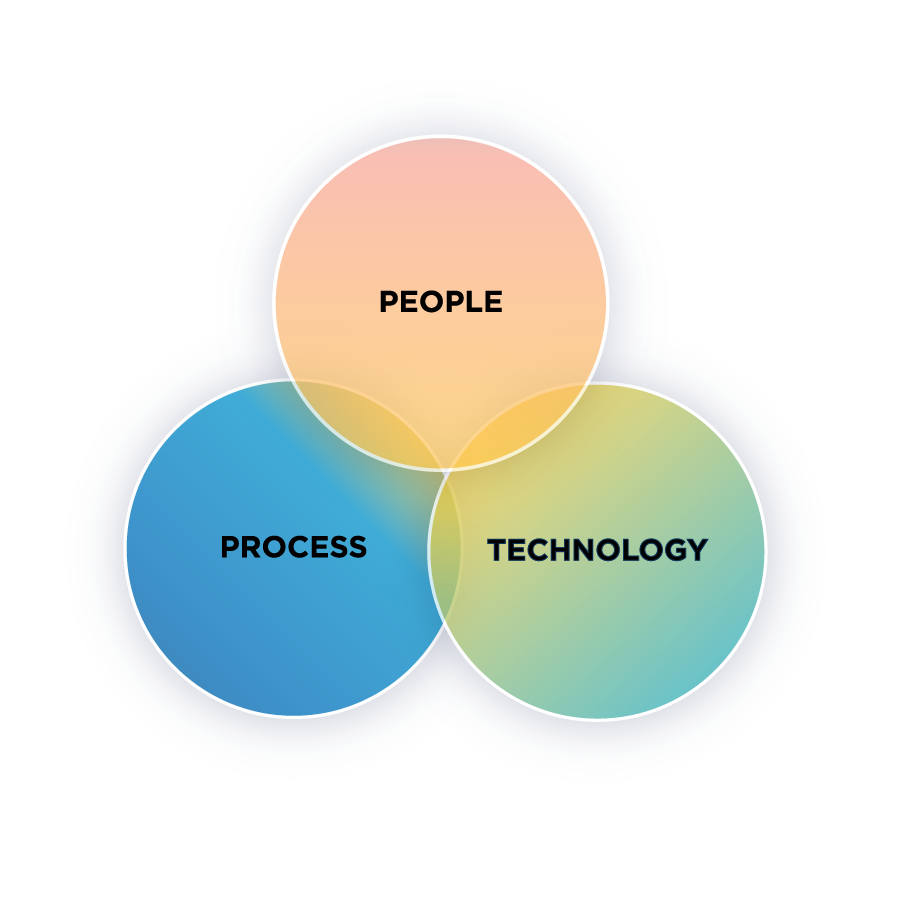Blog
Uncovering the Hidden Benefits of Intelligent Automation
Contact Us
The people, process, technology (PPT) framework is about the environment of interaction within a business, where the people work, the processes make work more efficient and technology helps people do or automate tasks. By balancing the three, organizations can achieve efficiency and cohesive, valuable results.
PPT isn’t about one piece of the puzzle being larger than the rest. For the pieces to fit together, they need to be of equal size, with equal weight given to them.
We call this balance a unified workforce. It’s where your humans and digital workers collaborate to make work more productive, accurate and effective. By unifying your workforce, you’ll see better output, improve employee satisfaction and give your staff more time to deliver better customer experiences.
The PPT framework emerged from work by business management expert Harold Leavitt in the early 1960s, who developed a working model for organizations. Originally, Leavitt’s diamond model included four elements: people, structure, tasks and technology.
The PPT framework evolved from Leavitt’s original work to show organizations where they could improve to create a more cohesive workforce. It combined the ‘structure’ and ‘tasks’ branches into one process-focused definition, creating the three-pronged PPT approach we know today.
Some refer to the PPT framework as the golden triangle, with three sides showing the equal importance of people, process and technology.

The people in your workforce are your human resources capable of working on complex tasks that utilize human intelligence and empathy. When interacting with technology and processes together, your people can enhance their jobs and remove repetitive, error-prone tasks from their workload.
Technology doesn’t have to detract from people’s work. When unifying your digital and people workforce, technologies like intelligent automation (IA) can actually make your people’s work more valuable.
By empowering your employees to upskill and establishing clear roles and responsibilities through citizen development, your organization can ensure your teams consist of the right people for the job.
Citizen development drastically simplifies the software development process and lowers development costs. It’s when non-technical employees are trained to create and run automation—a strategy that saves organizations from recruiting costs and hiring RPA developers during labor skill shortages. It helps establish a people-technology relationship and fosters an automation-first mindset in your organization.
Citizen development trains workers without coding experience and attitude for improvement to develop business process automation using no-code or low-code tools. To be successful, a citizen development program should involve a clear objective for your digital transformation strategy, training in best practices and organization-wide buy-in.
To give your development team guidance for easier automation scalability, consider introducing a Center of Excellence (CoE). A CoE establishes best practices, outlines training, ensures security and compliance, offers workshops and gives mentoring and support.
What are the benefits of citizen development?
A good model for citizen development is a CoE + IT + citizen developers.
The process is the actions or steps taken within a workflow to achieve a particular outcome. In business processes, it’s important to know how people and technology fit in. Intentional automation with a strategy is more effective than automating anything and everything.
Processes should be clearly outlined, and any bottlenecks removed. Then you can determine the best first candidates for automation and scale your growth from there, ensuring processes are always running at the best possible efficiency.
Technology on its own can’t solve every problem, but in working with people and processes, it can achieve enterprise-wide digital transformation. Technology PPT isn’t the goal—a balance of all three is.
Intelligent automation (IA) combines robotic process automation (RPA) with artificial intelligence (AI) and other technology-enabled solutions to automate tasks, streamline workflows and create a unified workforce.
With labor shared between digital and human workers, overworked employees can now focus on higher-value, fulfilling activities. Meanwhile, IA digital workers support data-driven decision-making and automate routine tasks, helping speed up processing and reduce errors. Plus, digital workers are available 24/7 to get even more work done.
PPT is a balance, where people do the work, technology helps them innovate and robust processes improve efficiency. As you improve your processes and integrate more technology with your people, you can scale your business to suit its growing needs. Below are some best practices for how you can transform an organization with the people, process and technology framework.

Through technologies such as business process management (BPM), users can get key insights to understand the processes in their business. Then they can identify opportunities and slowdowns and monitor how processes are worked through. BPM orchestrates work, so people and digital workers are delegated the right tasks for the best results.
Our BPM solution, SS&C | Blue Prism® Chorus, is a comprehensive business process management suite that includes digital process automation, case management, omnichannel communications and operational analytics to help organizations accelerate how work gets done.
Chorus automates handoffs between people and technology. And using a defined set of business rules including policies, requirements and conditional statements, Chorus lets you proactively automate workflows. It also offers a clear audit trail to support compliance and uses machine learning (ML) to predict if a work item might have an error. Finally, it improves communication with customers, bringing all interactions into one place to provide real-time statuses on all work items.
Once you have insights and control over your business processes, you can look at the best ways to unify your workforce with a step-by-step model.
The SS&C | Blue Prism® Robotic Operating Model (ROMTM) is a guide to implementing and running automation within your organization with the goal of continuous improvement. The ROM outlines robust foundations to maximize the value of your automation program at scale. The ROM works to align people, processes and technology.
Knowing which automation technologies to use and where, along with integration options, is critical to building a continuous, healthy pipeline of automation candidates for your business.
As we mentioned earlier, having guidelines and teams prepared will help you achieve best practices within your organization. With efficiency and productivity being two of the biggest drivers for automation, a CoE comprised of a team of automation experts focuses on robust and reusable design. The CoE is critical for a successful intelligent automation deployment, encouraging buy-in, instilling best practices and demonstrating tangible benefits back to the business.
SS&C Blue Prism’s automation solutions are interconnected to unify your people and digital workforce:
How do you strike a balance between building robust automations and delivering automated processes quickly? For most medium to large enterprises, the federated model is the best way to structure the RPA or automation team for success. Individual business functions can move as aggressively as needed, while knowledge and responsibility are distributed across the company.
We recommend BPPI for hands-off discovery and analysis. This allows you to quickly establish a pipeline of processes for your central automation team to build.
Next, export the task mining output into Capture for editing and optimization. There are two options for the next step. If you’re a business user, export the process from Capture straight into SS&C Blue Prism. This export contains object and application modeler data, which saves significant time during the build process. The process may then be handed off to your expert SS&C Blue Prism users for completion.
Alternatively, at the point of Capture export, an experienced automation developer may export the defined process into ALM and design a robust automation using Wireframer.
When you’re aiming for speedy delivery at scale, removing obstacles that increase complexity in building automations is your top priority. Your central automation team focuses more on governance, standards and oversight, instead of designing the automations themselves.
The optimal solution lies in initially using BPPI for discovery and then exporting the process into Capture, allowing for quick and easy process editing. From here, you can export directly to SS&C Blue Prism by automatically creating a process with object and application modeler data. This removes an enormous amount of build complexity for your citizen developers, saving time and effort.
The PPT framework can be used as a reference for your organization to balance the important aspects of your people, process and technology. This will ensure you’re investing in the right places and getting work done efficiently, accurately and on time.
Intelligent automation is about modernizing how your business operates. We’re shaping the future of work by developing more sophisticated ways to transform entire business functions rather than isolated processes. One initiative underway is secure and auditable integrations. Underpinned by a common data model, these integrations include a customizable user experience. Stay tuned as we continue to shape this incredibly exciting space.

Blog
Uncovering the Hidden Benefits of Intelligent Automation
White Paper
Federated Citizen Development: How to innovate faster with RPA
White Paper
Embarking on the Automation Journey: A Step by Step Playbook
If your network blocks YouTube, you may not be able to view the video on this page. In this case, please use another device. Pressing play on the video will set third-party YouTube cookies. Please read our Cookies Policy for more information.